|
|
|
Sort Order |
|
|
|
Items / Page
|
|
|
|
|
|
|
| Srl | Item |
| 1 |
ID:
151190
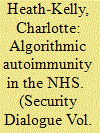

|
|
|
|
|
| Summary/Abstract |
This article explores the extension of counter-radicalisation practice into the National Health Service (NHS). In the 2011 reformulation of the UK Prevent strategy, the NHS became a key sector for the identification and suppression of ‘radicalisation’. Optometrists, dentists, doctors and nurses have been incorporated into counter-terrorism and trained to report signs of radicalisation in patients and staff. This article explores how calculative modalities associated with big data and digital analytics have been translated into the non-digital realm. The surveillance of the whole of the population through the NHS indicates a dramatic policy shift away from linear profiling of those ‘suspect communities’ previously considered vulnerable to radicalisation. Fixed indicators of radicalisation and risk profiles no longer reduce the sample size for surveillance by distinguishing between risky and non-risky bodies. Instead, the UK government chose the NHS as a pre-eminent site for counter-terrorism because of the large amount of contact it has with the public. The UK government is developing a novel counter-terrorism policy in the NHS around large-N surveillance and inductive calculation, which demonstrates a translation of algorithmic modalities and calculative regimes. This article argues that this translation produces an autoimmune moment in British security discourse whereby the distinction between suspicious and non-suspicious bodies has collapsed. It explores the training provided to NHS staff, arguing that fixed profiles no longer guide surveillance: rather, surveillance inductively produces the terrorist profile.
|
|
|
|
|
|
|
|
|
|
|
|
|
|
|
|
| 2 |
ID:
151191
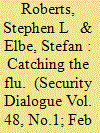

|
|
|
|
|
| Summary/Abstract |
How do algorithms shape the imaginary and practice of security? Does their proliferation point to a shift in the political rationality of security? If so, what is the nature and extent of that shift? This article argues that efforts to strengthen global health security are major drivers in the development and proliferation of new algorithmic security technologies. In response to a seeming epidemic of potentially lethal infectious disease outbreaks – including HIV/AIDS, Severe Acute Respiratory Syndrome (SARS), pandemic flu, Middle East Respiratory Syndrome (MERS), Ebola and Zika – governments and international organizations are now using several next-generation syndromic surveillance systems to rapidly detect new outbreaks globally. This article analyses the origins, design and function of three such internet-based surveillance systems: (1) the Program for Monitoring Emerging Diseases, (2) the Global Public Health Intelligence Network and (3) HealthMap. The article shows how each newly introduced system became progressively more reliant upon algorithms to mine an ever-growing volume of indirect data sources for the earliest signs of a possible new outbreak – gradually propelling algorithms into the heart of global outbreak detection. That turn to the algorithm marks a significant shift in the underlying problem, nature and role of knowledge in contemporary security policy.
|
|
|
|
|
|
|
|
|
|
|
|
|
|
|
|
| 3 |
ID:
151192


|
|
|
|
|
| Summary/Abstract |
Possibilities for crowdsourced surveillance have expanded in recent years as data uploaded to social networks can be mined, distributed, assembled, mapped, and analyzed by anyone with an uncensored internet connection. These data points are necessarily fragmented and partial, open to interpretation, and rely on algorithms for retrieval and sorting. Yet despite these limitations, they have been used to produce complex representations of space, subjects, and power relations as internet users attempt to reconstruct and investigate events while they are developing. In this article, I consider one case of crowdsourced surveillance that emerged following the detonation of two bombs at the 2013 Boston Marathon. I focus on the actions of a particular forum on reddit.com, which would exert a significant influence on the events as they unfolded. The study describes how algorithmic affordances, internet cultures, surveillance imaginaries, and visual epistemologies contributed to the structuring of thought, action, and subjectivity in the moment of the event. I use this case study as a way to examine moments of entangled political complicity and resistance, highlighting the ways in which particular surveillance practices are deployed and feed back into the event amid its unfolding.
|
|
|
|
|
|
|
|
|
|
|
|
|
|
|
|
| 4 |
ID:
151189
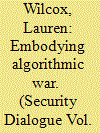

|
|
|
|
|
| Summary/Abstract |
Through a discussion of drone warfare, and in particular the massacre of 23 people in the Uruzgan province in Afghanistan in 2010, I argue that drone warfare is both embodied and embodying. Drawing from posthuman feminist theorists such as Donna Haraway and N Katherine Hayles, I understand the turn toward data and machine intelligence not as an other-than-human process of decisionmaking that deprives humans of sovereignty, but as a form of embodiment that reworks and undermines essentialist notions of culture and nature, biology and technology. Through the intermediation of algorithmic, visual, and affective modes of embodiment, drone warfare reproduces gendered and racialized bodies that enable a necropolitics of massacre. Finally, the category of gender demonstrates a flaw in the supposed perfectibility of the algorithm in removing issues of identity or prejudice from security practices, as well as the perceptions of drone assemblages as comprising sublime technologies of perfect analysis and vision. Gender as both a mode of embodiment and a category of analysis is not removed by algorithmic war, but rather is put into the service of the violence it enables.
|
|
|
|
|
|
|
|
|
|
|
|
|
|
|
|
| 5 |
ID:
151193
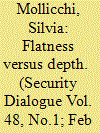

|
|
|
|
|
| Summary/Abstract |
For the past two decades, the camouflage patterns used on military uniforms have been computed by families of algorithms. The article argues that these computation methods fit within a genealogy of discourses on camouflage practices, which the text reconstructs along the axes of flatness and depth. Camouflage can be explained as an attempt at flattening information related to a target onto the underlying background, by producing general invariances within the environment and in accordance with the observer’s perceptive faculties. Carrying out this task, static camouflage responds to the aporia of using one pattern to disguise presence within multiple contexts. After analysing two discourses on camouflage in relation to the notion of flatness, the article considers a case of algorithmically generated static camouflage. Its disguising method abstracts information from both the environment in which an army is expected to fight and the observer’s perceptive capacities and then computes these threads of abstraction together in a pattern. The meshing function of computation thus flattens the principles embedded in the fabric, making them individually illegible. This changes the value that camouflage usually gives to target/background relations and to the observer’s perceptive faculties.
|
|
|
|
|
|
|
|
|
|
|
|
|
|
|
|
| 6 |
ID:
151188
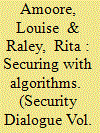

|
|
|
|
|
| Summary/Abstract |
Amid the deployment of algorithmic techniques for security – from the gathering of intelligence data to the proliferation of smart borders and predictive policing – what are the political and ethical stakes involved in securing with algorithms? Taking seriously the generative and world-making capacities of contemporary algorithms, this special issue draws attention to the embodied actions of algorithms as they extend cognition, agency and responsibility beyond the conventional sites of the human, the state and sovereignty. Though focusing on different modes of algorithmic security, each of the contributions to the special issue shares a concern with what it means to claim security on the terrain of incalculable and uncertain futures. To secure with algorithms is to reorient the embodied relation to uncertainty, so that human and non-human cognitive beings experimentally generate and learn what to bring to the surface of attention for a security action.
|
|
|
|
|
|
|
|
|
|
|
|
|
|
|
|
|
|
|
|
|